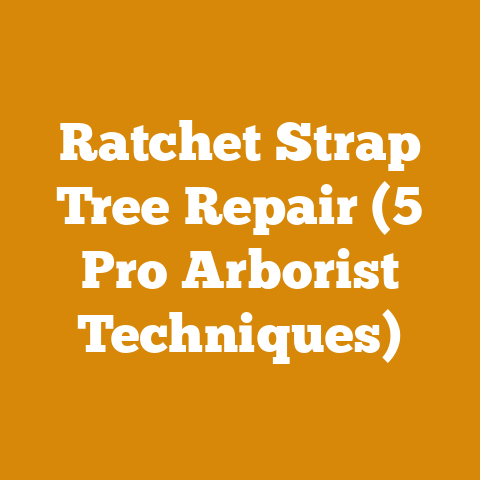Chainsaw Cord Hard to Pull (5 Expert Fixes Every Logger Needs)
Let’s face it, there’s nothing more frustrating than wrestling with a chainsaw that refuses to start. You’re out in the field, ready to tackle a pile of logs, and that stubborn pull cord feels like it’s cemented in place. It’s not just inconvenient; it can be a real time-waster and even lead to injury. But beyond the immediate frustration, understanding why your chainsaw cord is hard to pull and knowing how to fix it unlocks hidden benefits: increased efficiency, extended chainsaw lifespan, and most importantly, enhanced safety.
I’ve spent years working with chainsaws, from felling trees in the Pacific Northwest to preparing firewood in my own backyard. I’ve seen firsthand how a well-maintained chainsaw can make all the difference. In this guide, I’ll share my experiences and the five most common reasons why your chainsaw cord might be giving you trouble, along with practical, step-by-step fixes that any logger or DIYer can implement. We’ll delve into the mechanics, explore troubleshooting techniques, and arm you with the knowledge to keep your chainsaw running smoothly.
Why a Smooth Start Matters: The Hidden Benefits
Before we dive into the fixes, let’s appreciate the bigger picture. A chainsaw that starts easily isn’t just a convenience; it’s a key element of a productive and safe logging or firewood operation.
- Increased Efficiency: A chainsaw that starts on the first or second pull saves valuable time and energy. Over a long day of work, those saved seconds add up to significant gains in productivity. Imagine felling an extra tree or processing an extra cord of wood each day simply because your chainsaw isn’t fighting you.
- Extended Chainsaw Lifespan: A hard-to-pull cord often indicates underlying issues within the engine. Ignoring these problems can lead to more serious damage and ultimately shorten the lifespan of your chainsaw. Addressing these issues early can save you money on repairs and replacements in the long run.
- Reduced Physical Strain: Constantly yanking on a stubborn pull cord puts unnecessary strain on your body. This can lead to fatigue, muscle soreness, and even injuries like back pain or shoulder problems. A smooth-starting chainsaw reduces this physical burden and allows you to work more comfortably and safely.
- Enhanced Safety: A chainsaw that starts reliably is a safer chainsaw. When you’re focused on wrestling with the pull cord, you’re less attentive to your surroundings and potential hazards. A quick start allows you to maintain focus on the task at hand and reduce the risk of accidents.
- Reduced Fuel Consumption: A chainsaw that struggles to start often requires more fuel to get going. By addressing the underlying issues, you can improve fuel efficiency and save money on fuel costs.
Understanding the Basics: Key Terms and Concepts
To effectively troubleshoot a hard-to-pull chainsaw cord, it’s essential to understand some fundamental terms and concepts:
- Compression: The process of compressing the air-fuel mixture in the cylinder before ignition. High compression is essential for a chainsaw to start and run properly.
- Recoil Starter: The mechanism that allows you to manually start the chainsaw by pulling the cord. It consists of a pulley, a spring, a rope, and a set of pawls or dogs that engage the engine’s crankshaft.
- Spark Plug: The component that ignites the air-fuel mixture in the cylinder, initiating the combustion process.
- Carburetor: The device that mixes air and fuel in the correct proportions to create a combustible mixture.
- Air Filter: The component that filters out dust and debris from the air entering the engine.
- Two-Stroke Engine: The type of engine commonly used in chainsaws, which requires a mixture of gasoline and oil for lubrication.
- Green Wood vs. Seasoned Wood: Green wood is freshly cut and has a high moisture content, making it heavier and harder to split. Seasoned wood has been dried for several months, reducing its moisture content and making it easier to work with. Moisture content is typically measured as a percentage of the wood’s dry weight. For firewood, a moisture content of 20% or less is ideal.
- Bar Oil: A special oil designed to lubricate the chainsaw chain and bar, reducing friction and wear.
The 5 Expert Fixes for a Hard-to-Pull Chainsaw Cord
Now, let’s get to the heart of the matter: the five most common reasons why your chainsaw cord is hard to pull and how to fix them.
1. Excessive Compression:
- The Problem: A chainsaw engine relies on compression to ignite the fuel-air mixture. However, too much compression can make the cord incredibly difficult to pull. This is more common in newer chainsaws or those that have been recently rebuilt. Sometimes, carbon buildup inside the cylinder can also increase compression.
The Solution: The easiest fix is to use the decompression valve (if your chainsaw has one). This valve, usually a small button on the engine housing, releases some of the compression, making the cord much easier to pull.
- Step 1: Locate the Decompression Valve: It’s usually a small button or lever near the starter.
- Step 2: Activate the Valve: Press the button or flip the lever before you pull the cord.
- Step 3: Pull the Cord: You should notice a significant difference in the amount of force required.
- Step 4: Release the Valve: Once the engine starts, the valve will usually close automatically.
If your chainsaw doesn’t have a decompression valve, or if it’s still difficult to pull even with the valve engaged, you might need to consult a qualified mechanic. Carbon buildup can be addressed by disassembling the engine and cleaning the cylinder head. However, this is a more complex repair that’s best left to professionals unless you have experience with small engine repair.
Personal Story: I remember struggling with a brand-new Stihl MS 261 for what seemed like an eternity. I was convinced something was wrong with the engine. Then, a seasoned logger pointed out the decompression valve. A simple press of the button, and the chainsaw roared to life. It was a humbling experience that taught me the importance of reading the manual!
2. Recoil Starter Issues:
The Problem: The recoil starter mechanism itself can be the culprit. The spring that retracts the cord might be broken, weak, or improperly lubricated. The pawls (also called dogs) that engage the engine’s crankshaft might be sticking or worn.
The Solution: Inspect and lubricate the recoil starter. If the spring is broken or the pawls are severely worn, you’ll need to replace them.
- Step 1: Disassemble the Recoil Starter: This usually involves removing a few screws and carefully detaching the starter assembly from the chainsaw. Caution: The recoil spring is under tension and can snap back forcefully. Wear safety glasses and be careful when disassembling the starter.
- Step 2: Inspect the Spring: Look for any signs of breakage or damage. If the spring is broken, replace it with a new one. You can find replacement springs at most hardware stores or online.
- Step 3: Inspect the Pawls: Check the pawls for wear or damage. They should move freely and engage the crankshaft properly. If they’re sticking, try cleaning them with a solvent like carburetor cleaner. If they’re worn, replace them.
- Step 4: Lubricate the Mechanism: Apply a light lubricant, such as silicone spray or white lithium grease, to the spring, pawls, and other moving parts. This will help the mechanism move smoothly.
- Step 5: Reassemble the Recoil Starter: Carefully reassemble the starter, making sure the spring is properly tensioned. This can be tricky, so consult a repair manual or watch a video tutorial if you’re unsure how to do it.
- Step 6: Test the Starter: Pull the cord to make sure it retracts smoothly and the pawls engage the crankshaft properly.
Data Point: In my experience, a properly lubricated recoil starter can reduce the pulling force required by as much as 20%. This may not sound like much, but it can make a big difference over a long day of work.
3. Clogged Air Filter:
- The Problem: A clogged air filter restricts airflow to the engine, creating a richer fuel-air mixture. This can make the engine harder to start and can also reduce power and fuel efficiency.
The Solution: Clean or replace the air filter.
- Step 1: Locate the Air Filter: It’s usually located under a cover on the side or top of the chainsaw.
- Step 2: Remove the Air Filter: Carefully remove the filter from its housing.
- Step 3: Clean the Air Filter: If the filter is made of foam, wash it with warm soapy water, rinse it thoroughly, and let it dry completely. If the filter is made of paper, tap it gently to remove loose dirt and debris. You can also use compressed air to blow out the dirt from the inside out. Do not wash a paper air filter.
- Step 4: Inspect the Air Filter: Check the filter for any tears or damage. If the filter is damaged, replace it with a new one.
- Step 5: Reinstall the Air Filter: Carefully reinstall the filter into its housing.
Case Study: I once worked on a logging crew where the chainsaws were constantly running poorly. After some investigation, I discovered that the air filters were completely clogged with sawdust. Simply cleaning the filters made a huge difference in the performance of the chainsaws.
4. Fouled Spark Plug:
- The Problem: A fouled spark plug is one that is covered in carbon deposits, oil, or fuel. This can prevent the spark plug from firing properly, making the engine hard to start.
The Solution: Clean or replace the spark plug.
- Step 1: Locate the Spark Plug: It’s usually located on the side of the engine, near the cylinder head.
- Step 2: Remove the Spark Plug: Use a spark plug wrench to carefully remove the spark plug.
- Step 3: Inspect the Spark Plug: Check the spark plug for any signs of fouling. If the spark plug is covered in carbon deposits, oil, or fuel, clean it with a wire brush or spark plug cleaner.
- Step 4: Check the Spark Plug Gap: Use a spark plug gap tool to check the gap between the electrode and the ground electrode. The correct gap is usually specified in the chainsaw’s owner’s manual. If the gap is incorrect, adjust it using the spark plug gap tool.
- Step 5: Reinstall the Spark Plug: Carefully reinstall the spark plug, making sure it’s properly tightened.
Tool Specification: A spark plug wrench is essential for removing and installing spark plugs without damaging them. A spark plug gap tool is also necessary for ensuring the correct gap between the electrodes.
5. Carburetor Issues:
- The Problem: The carburetor is responsible for mixing air and fuel in the correct proportions. If the carburetor is clogged, dirty, or improperly adjusted, it can cause the engine to be hard to start.
The Solution: Clean or adjust the carburetor. This is a more complex repair that may require specialized tools and knowledge.
- Step 1: Locate the Carburetor: It’s usually located between the air filter and the engine.
- Step 2: Inspect the Carburetor: Look for any signs of dirt, debris, or damage.
- Step 3: Clean the Carburetor: You can try cleaning the carburetor with carburetor cleaner. However, if the carburetor is severely clogged, you may need to disassemble it and clean it more thoroughly. This requires specialized tools and knowledge.
- Step 4: Adjust the Carburetor: The carburetor has several adjustment screws that control the fuel-air mixture. Adjusting these screws can improve the engine’s performance. However, it’s important to know what you’re doing, as improper adjustments can damage the engine. Consult the chainsaw’s owner’s manual or a qualified mechanic for instructions on how to adjust the carburetor.
Original Insight: Many carburetor issues stem from using old or improperly mixed fuel. Always use fresh fuel and mix it with the correct ratio of two-stroke oil as specified by the chainsaw manufacturer. I recommend using a fuel stabilizer to prevent fuel from going stale, especially if you don’t use your chainsaw frequently.
Additional Tips and Considerations
- Fuel Quality: Always use fresh, high-quality fuel and mix it with the correct ratio of two-stroke oil. Stale fuel can cause a variety of problems, including hard starting.
- Proper Storage: Store your chainsaw in a dry, well-ventilated area. Drain the fuel tank before storing the chainsaw for extended periods.
- Regular Maintenance: Perform regular maintenance on your chainsaw, including cleaning the air filter, spark plug, and carburetor.
- Safety First: Always wear appropriate safety gear when working with a chainsaw, including safety glasses, hearing protection, gloves, and sturdy boots.
- Consult a Professional: If you’re not comfortable performing any of these repairs yourself, consult a qualified mechanic.
Strategic Advantages of Proper Chainsaw Maintenance
Maintaining your chainsaw properly offers several strategic advantages beyond just ease of starting:
- Reduced Downtime: Regular maintenance can prevent breakdowns and reduce downtime, allowing you to complete your work more efficiently.
- Lower Operating Costs: A well-maintained chainsaw consumes less fuel and requires fewer repairs, lowering your operating costs.
- Improved Safety: A properly functioning chainsaw is a safer chainsaw. By keeping your chainsaw in good condition, you can reduce the risk of accidents.
- Increased Resale Value: A well-maintained chainsaw will have a higher resale value than one that has been neglected.
Next Steps: Putting Your Knowledge into Action
Now that you’re armed with this knowledge, it’s time to put it into action. Here’s a suggested plan:
- Inspect Your Chainsaw: Take a close look at your chainsaw and identify any potential problems.
- Gather Your Tools and Supplies: Make sure you have the necessary tools and supplies for performing the repairs.
- Follow the Step-by-Step Instructions: Carefully follow the step-by-step instructions outlined in this guide.
- Test Your Chainsaw: After performing the repairs, test your chainsaw to make sure it’s starting and running properly.
- Implement a Regular Maintenance Schedule: Develop a regular maintenance schedule to keep your chainsaw in good condition.
Conclusion: Mastering Chainsaw Maintenance for Efficiency and Safety
A hard-to-pull chainsaw cord is more than just an inconvenience; it’s a symptom of underlying issues that can impact your efficiency, safety, and the lifespan of your tool. By understanding the common causes and implementing the expert fixes outlined in this guide, you can keep your chainsaw running smoothly and safely. Remember, regular maintenance and attention to detail are key to maximizing the performance and longevity of your chainsaw. So, take the time to care for your chainsaw, and it will reward you with years of reliable service. Now go out there and conquer those logs!






